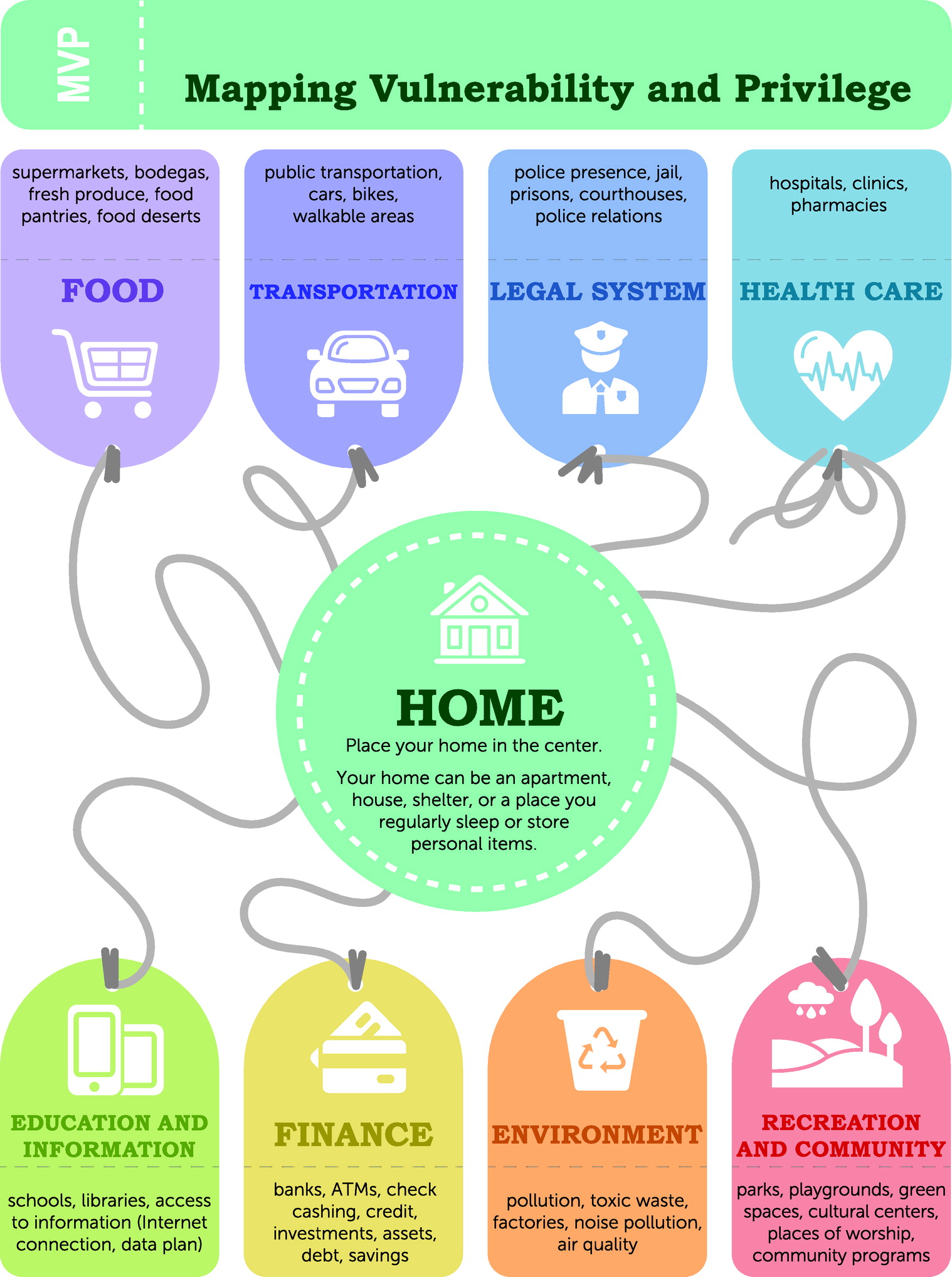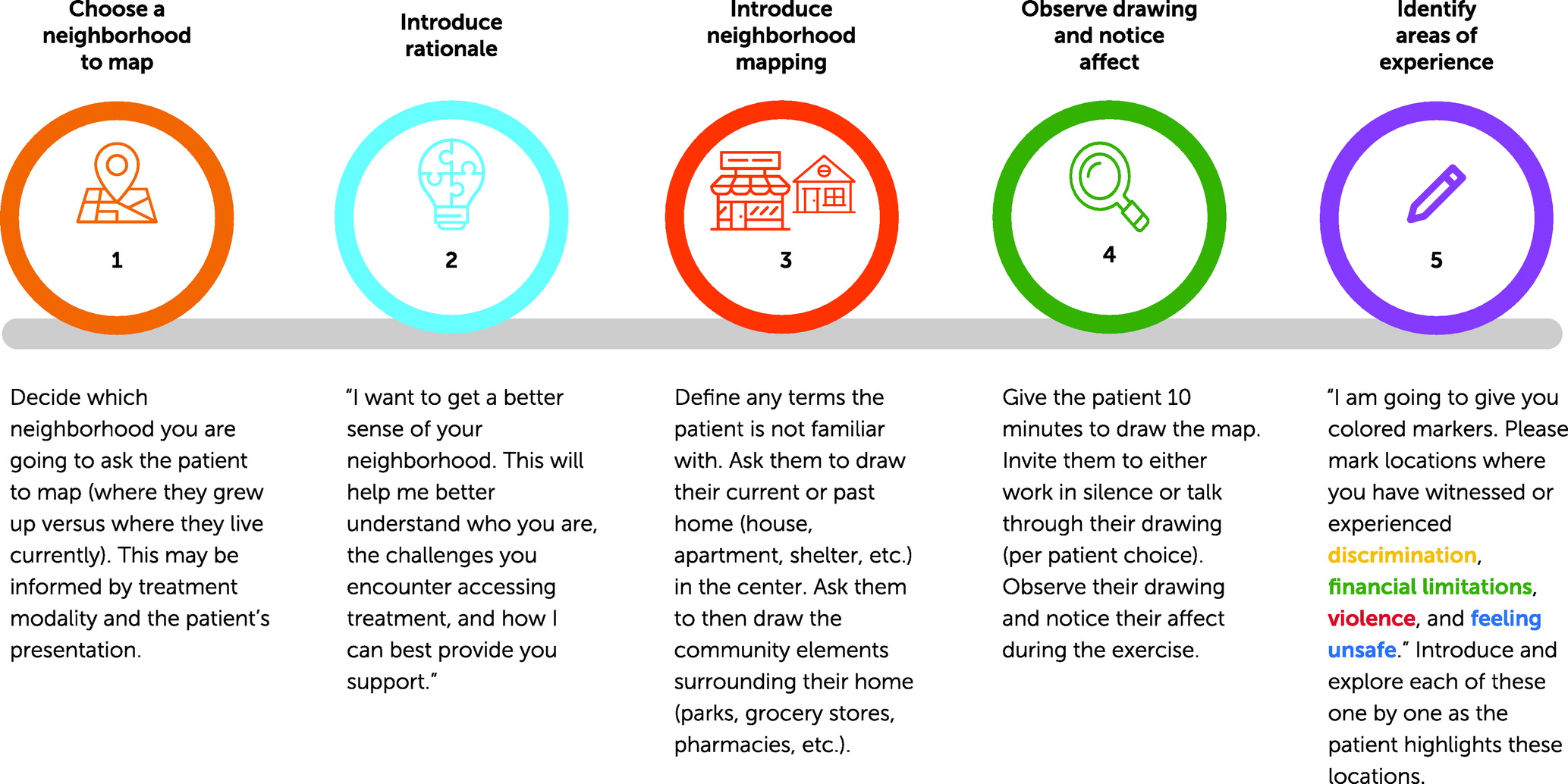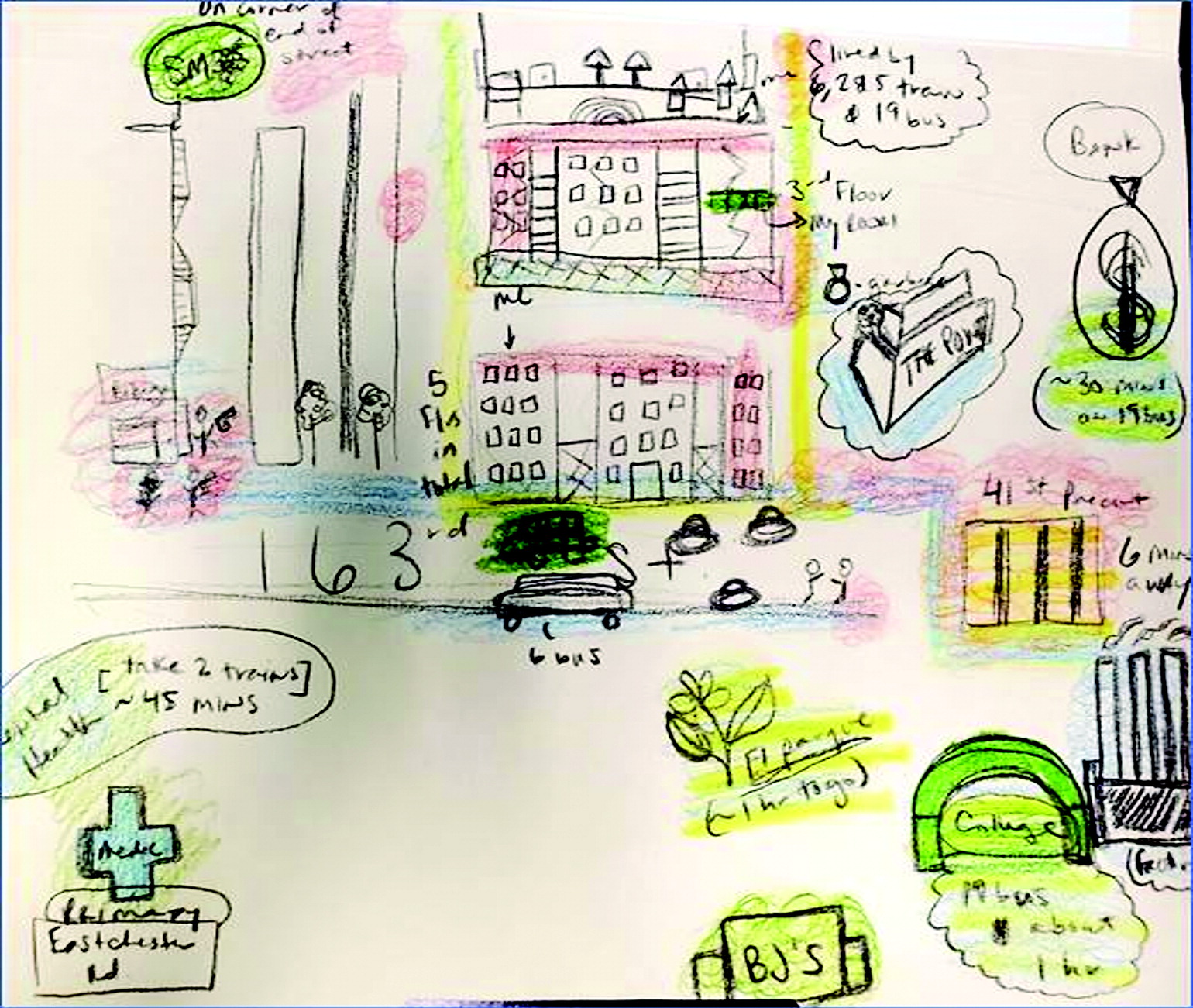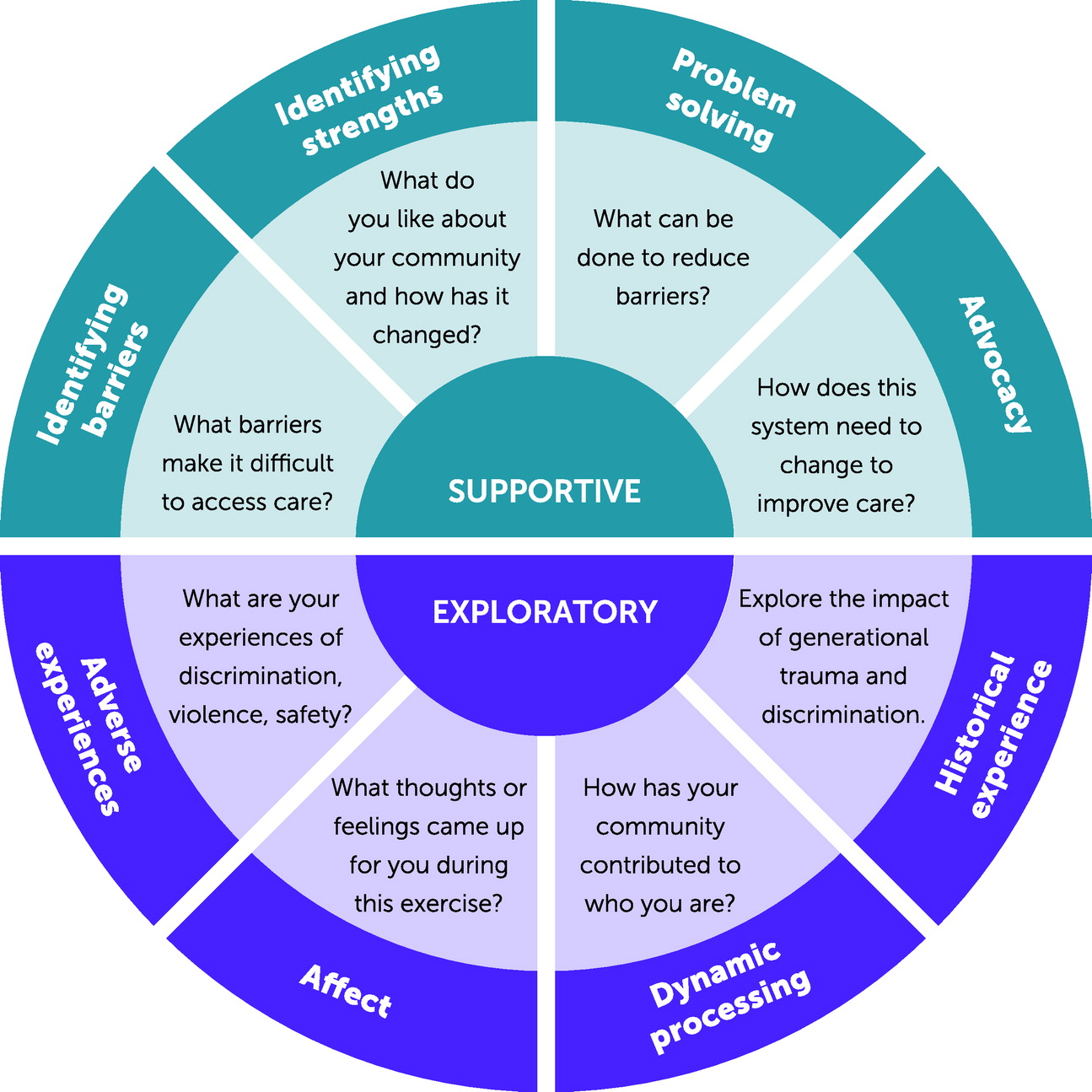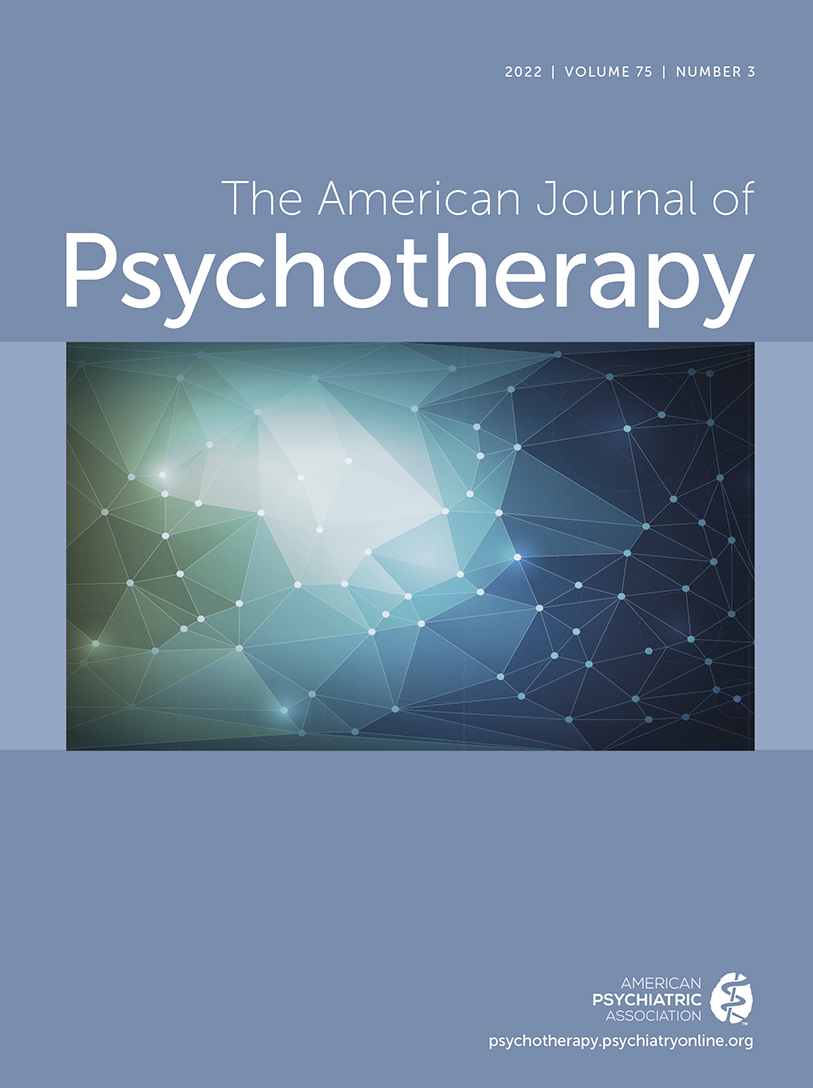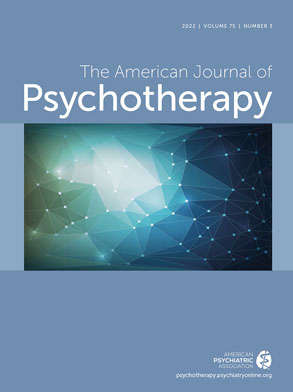Structural competency as a framework has forged an important paradigm shift for medical education and approaches to public health (
1,
2). The concept of structural competency encourages consideration of the institutional, political, and economic forces that shape patients’ symptom expression, clinical problems, disease, and health outcomes, as well as attitudes toward patients. These established structures unevenly distribute opportunities to individuals and groups—or eliminate opportunities completely—largely along racial-ethnic lines. Structural racism is the result of the historical, cultural, media, political, and economic systems that shape daily life and afford preferential treatment and power to White people at the expense of Black, Latinx, Asian, and other oppressed racial-ethnic groups. Institutional, interpersonal, and internalized types of racism arise from these interconnected systems (
3). Structures that perpetuate inequality through policies (e.g., redlining), economic systems (e.g., disparate resource allocation), and social hierarchies (e.g., classism) have downstream impacts on multiple domains (e.g., housing, jobs, education, transportation, environmental conditions, immunomodulation) and lead to adverse health outcomes (
3,
4). These structural determinants of health are responsible for the quality of the conditions in which people are born, live, work, play, and worship, which have broad impacts on health and quality of life (
3–
9).
The founders of the structural competency framework, Jonathan Metzl and Helena Hansen, proposed a model to incorporate these determinants of health that consists of five components: recognizing structures that shape clinical interactions, developing an extraclinical language of structure, rearticulating cultural presentations in structural terms, observing and imagining structural interventions, and developing structural humility (
1). Multipronged approaches have been used to operationalize this model in medical education and treatment. Notably, curriculum development in medical education has increasingly focused on structural competency (
1,
10–
14). Furthermore, the literature has increasingly highlighted the importance of power sharing and community engagement as health care interventions (e.g., encouraging voter registration and civic engagement among patients receiving mental health care) (
15). Additionally, the Structural Vulnerability Assessment Tool (
16) was created as a standardized assessment of the structural determinants of health. This tool helps clinicians gauge aspects of the patient’s structural vulnerability, which refers to the specific local, regional, and global hierarchies, power relationships, and infrastructures that can exacerbate a patient’s health problems in certain communities and within marginalized populations (
13). Through an initial screening and qualitative assessment, this 43-item questionnaire assesses patients’ needs across the following domains: economic stability, education, social and community context, health and clinical care, neighborhood and physical environment, and food.
The Mapping Vulnerability and Privilege (MVP) exercise was developed at Montefiore Medical Center’s Department of Psychiatry and Behavioral Sciences with the goal of adding to this body of work. The MVP exercise facilitates the practice of structural humility in several ways. It is meant to enhance reflection among clinicians by encouraging them to evaluate their own structural privilege and vulnerability. It is a clinical intervention with a structural focus that can be used in the therapeutic space. Finally, it provides an opportunity to explore the relationship between structural forces and the patient’s experience, which can be used as a launching pad to explore structural action that both the clinician and the patient can pursue. Similar to the benefits of art therapy, this exercise incorporates drawing to help engage patients with difficult material and offers them a chance to control how their environment is depicted (
17). The agency patients have in creating their drawing empowers them as collaborators in their care without the presumption implicit in a questionnaire.
The MVP exercise comprises the MVP Tool, Visual Guide, and Processing Guide. Using the MVP Tool, patients first draw a picture of their community by mapping the components of their neighborhood that are associated with the structural and social determinants of health. They then expand on this image by using a color-coded system to indicate barriers to access related to their lived experiences. Identifying these “domains of experience” helps to further illuminate structural vulnerabilities. The MVP Visual Guide is a resource for clinicians to guide patients through the community mapping portion of the exercise. The MVP Processing Guide is an additional resource that clinicians can use to generate dialogue about the impact of structural determinants on the patient’s overall general medical and mental health. It serves to promote psychotherapeutic interventions by integrating the structural tool with a guided reflection on the patient’s unique domains of experience.
Developing the MVP Exercise: Mapping the Neighborhood
The MVP exercise developed by the team at Montefiore Medical Center was an extension of the innovative work at the Yale School of Medicine’s Department of Psychiatry. The Yale team introduced the concept of neighborhood mapping—creating a visual representation of one’s community with symbols and pictures of essential domains (
11,
14). Providers used neighborhood mapping as an educational exercise to engage with psychiatry residents, psychiatrists, and other mental health professionals about social determinants of health as part of their broader Structural Competency Community Initiative. Clinicians were asked to map the neighborhoods in which they grew up, with their homes at the center of the map. Elements of the community were then drawn around the providers’ homes. Yale’s neighborhood maps included the following domains: health care, financial, education, legal, transportation, nutrition, environmental, discrimination, and recreation. Through this exercise, providers could process their structural privilege and reflect on how these privileges may affect their health care delivery and may differ from those of the patients they work with. At Yale, clinicians were also invited to map their patients’ neighborhoods on the basis of their understanding of the patients’ communities.
Yale’s concept of neighborhood mapping seemed to be aligned with our nascent efforts to develop a structural competency curriculum in Montefiore’s adult psychiatry residency training program. Incorporating neighborhood mapping into Montefiore’s curriculum was an important step in supporting trainees’ recognition of structures that inform clinical interactions and their development of structural humility. However, we wanted to develop an exercise that could first be done with residents as an educational activity and then replicated with patients as a clinical intervention. The exercise was developed for three fundamental purposes: to allow residents an opportunity to reflect on their experience of creating and processing their map versus their patients’ experiences, to facilitate the incorporation of structural considerations into assessment and treatment planning, and to empower both the resident and patients to identify opportunities to take action to address systemic and structural issues. A work group comprising the authors of this article, including the clinical director of outpatient services, the training director, and psychiatry residents, took on the task of modifying and adapting community mapping to create a clinical intervention that could be utilized in the therapeutic milieu.
The neighborhood mapping exercise as presented by the Yale team was piloted for use with a small sample of approximately five patients in our adult outpatient psychiatry program. Based on that pilot, the following modifications were made to the mapped elements. We replaced “nutrition” with “food,” because this term was closer to the language used by the patients in our initial pilot. The domain of education was modified to “education and information” to more explicitly consider digital access. The recreation domain was changed to “recreation and community” to encourage the inclusion of community centers and places of worship.
The following anecdotal findings were identified during the initial piloting phase. Even when resources in the community seemed to be accessible (e.g., proximity to public transportation, availability of medical care centers), other aspects of lived experiences interfered with access. These barriers largely fell into four categories: fear and feeling unsafe, having witnessed or experienced physical or psychological violence related to a domain, financial barriers, and discrimination. To identify these barriers, the mapping exercise was redesigned to be conducted in a two-step process that assessed for these domains of experience.
The MVP Tool (
Figure 1) was designed as an easy-to-read, colorful infographic that could be given to the person creating the map. The person completing the map also needs white paper and markers, crayons, or colored pencils in black, red, blue, green, and yellow. First, the patient is asked to map the domains related to social and structural determinants of health in black. Then, the participant is invited to utilize a color-coded system to mark the neighborhood map with different colors that indicate different domains of experience. Discrimination was already identified as an element on Yale’s neighborhood map. However, it was removed from the initial mapped component and tracked as part of the color-coded system of experience because our pilot exercise demonstrated that discrimination could be experienced in multiple domains of one’s community. Patients are asked to denote the following: areas where they witnessed or experienced violence marked in red, areas where they felt unsafe marked in blue, areas where they experienced financial limitations marked in green, and areas where they experienced discrimination marked in yellow.
The MVP Visual Guide
The MVP Visual Guide (
Figure 2) is a worksheet designed for the clinician that provides guidance on how to introduce the MVP Tool to the patient and facilitate the mapping exercise. After the patient has been provided with the appropriate supplies, including the MVP Tool; white paper; and appropriately colored markers, crayons, or colored pencils, the clinician can begin the exercise. In step 1, the clinician should consider which neighborhood the patient should be asked to map. If providing a certain modality of care, the clinician may encourage the patient to map a neighborhood that would align best with the clinician’s therapeutic approach. For instance, clinicians practicing cognitive-behavioral therapy and other time-limited, target-focused modalities may benefit from asking patients to map their current neighborhood. Exposures and behavioral interventions can be generated to address treatment issues illuminated through the exercise. Alternatively, those practicing psychodynamic or relational approaches may find that mapping the neighborhood in which the patient grew up can be helpful in fostering the patient’s insight into how their community of origin influences their current patterns. Housing instability and frequent moves may need to be considered in guiding patients about which neighborhood to map. When in doubt, allow the patient or family to choose any neighborhood that they feel is most significant to them.
In step 2, the rationale of the mapping exercise should be discussed with the patient. The exercise should be framed as an opportunity to deepen understanding of the patient’s presenting problem, identify challenges to the patient’s ability to access care, and help the patient navigate environmental stressors.
In step 3, the clinician should define any unfamiliar terms in the MVP Tool and provide examples of what the patient may denote on the map to symbolize each domain. Once the patient understands all the domains to map, the patient is directed to draw his or her home in the middle of the page. The home can be a house, apartment, shelter, or where the patient usually sleeps at night. The patient is then invited to draw the community elements surrounding his or her home. Assistance can be offered to the patient in estimating distances between structures and proximity to the home, if necessary.
In step 4, the patient should be given approximately 10 minutes to finish drawing the home and relevant domains as indicated in the MVP Tool. Clinicians should invite the patient to either work in silence or talk while drawing—whatever feels most comfortable—and should observe the patient’s affect, what they draw, and what they share during the exercise.
In step 5, the clinician guides the patient in identifying areas of experience. The patient is directed to take the yellow marker, crayon, or colored pencil and mark locations of discrimination experiences in the neighborhood. The clinician should define discrimination if needed and have the patient or a family member talk through their experience, including how it relates to aspects of their identity, while they make the notations. Next, the clinician invites the patient to identify in green financial limitations that have affected the ability to travel or use a service that may exist in the community. Clinicians should encourage the patient to describe what they are marking and, if possible, have them describe the details of their financial hardship. Violence the patient has witnessed or experienced, which may be physical or psychological, should then be marked in red. Clinicians should encourage the patient to clarify whether the notation is related to witnessed or directly experienced violence and, if possible, to describe these experiences. Finally, using blue, the patient should mark unsafe areas. If possible, the patient should identify what makes that area feel unsafe. If the patient did not describe the elements of the map while drawing it, the clinician should ask the patient to “walk” the clinician through the neighborhood. Clinicians are encouraged to allow 20–30 minutes for the creation of the map and identification of elements and experiences. When the exercise was piloted, most patients completed this portion in 10–15 minutes, but the processing time varied greatly among participants.
Figure 3 shows an example of a completed MVP map.
Case Example
Using the MVP Processing Guide to Identify Entry Points for Structural Action
We developed the MVP Processing Guide as an infographic (
Figure 4) to aid in the clinical processing of the MVP exercise. It offers clinical prompts that can be helpful in reviewing the patient’s completed map and can be utilized in multiple therapeutic modalities and in treatment planning. The clinician should engage the patient in a collaborative discussion about how identified structures and domains of experience can affect both the patient’s engagement in and access to treatment as well as symptom presentation. Depending on the individual patient and current presentation, the therapist may choose to process the map using a supportive approach, an exploratory approach, or aspects of both. With a supportive approach, the goal is to support functioning by asking questions that help the patient identify the barriers and strengths of the neighborhood and to use problem solving to reduce the effect of such barriers on the patient’s health. With an exploratory approach, the goal is to help the patient develop a deeper understanding of themselves by eliciting a narrative of their experiences, identifying the associated affect, and exploring how their community and lived experiences contribute to their sense of self. With both approaches, the clinician can work collaboratively with the patient to identify structural actions that can be taken. Possibilities may include joining a peer advisory committee, organizing a social media campaign to highlight a systemic issue, attending a march or protest, writing an op-ed for a local paper, registering to vote, or contacting local legislators. This exercise is also intended to promote reflection by the clinician and prompt increased clinician engagement in actions to address the systemic and structural issues that affect the patient’s well-being.
Early Implementation
Thirty-six psychiatry residents and approximately 30 interdisciplinary faculty members have been trained on the MVP exercise and have completed their own maps. The training was paired with an overview of key terms and concepts related to structural competency. Twenty adult patients receiving care in a community mental health clinic in the New York City borough of the Bronx have completed the MVP exercise. The patients were all current Bronx residents, and most were Latinx and Black. The sample had transdiagnostic presentations and a variety of treatment goals and considerations. Patients selected had to be willing to engage in the MVP exercise and not be acutely suicidal, violent, or psychotic or have any other significant presenting risk at the time the exercise was introduced. Clinicians selected patients who were having difficulty attending appointments or adhering to medications or homework or who frequently arrived late to appointments.
On average, introducing the MVP exercise and the patient’s completion of the two-step mapping process took 10–15 minutes. The length of time for processing varied greatly across the sample. Anecdotally, the clinicians involved in the pilot found the MVP exercise to be helpful in facilitating conversations about structural barriers to care and considering structural actions to take.
Reflecting on the MVP Exercise
We highly encourage all clinicians using the MVP exercise with patients to first map their own neighborhood in order to reflect on their own structural privileges and vulnerabilities, because this process may shape their attitudes and beliefs about the patients with whom they work. The following questions should be considered on completion of one’s map. What structural privileges have you been afforded? Do any of these privileges influence the ways in which you interact (interpersonally or systemically) with your patient or their family? What impact does structural racism have on this patient’s personal and community health? How might your race-ethnicity or other aspects of your identity influence the patient’s experience of care? How might your map compare with those of the patients with whom you work? We also invite clinicians who utilize the MVP clinical intervention to consider the following questions. Did this experience change your conceptualization of the patient’s case? Do you experience any negative attitudes toward the patient that can be better understood through the lens of structural competency? Does your current treatment plan adequately consider structural racism and other barriers? Did you identify any areas that interfere with or could interfere with the patient’s ability to access care or stay engaged in care? What action can you take to change the structural conditions that negatively affect your patient? Did you learn anything new about the patient through this experience?
Conclusions
In this article, we outline the process for developing the MVP exercise, comprising the MVP Tool, Visual Guide, and Processing Guide, and provide guidance for its use both as an educational tool for clinicians and as a therapeutic intervention for patients. With an emerging focus on the importance of structural competency in the field of mental health, it is essential that clinicians continue to foster discussions on the structural forces that affect patients while empowering both themselves and their patients to take action to address systemic and structural issues (
Box 1). Although this intervention focuses primarily on barriers in an effort to increase awareness of structural competency and to provide context to both the clinician and patient, future modifications may ask participants to map resiliencies and strengths alongside barriers. Future research should focus on identifying and evaluating the effectiveness of the MVP exercise in regard to patient outcomes and on evaluating applications for different populations and treatment settings.
Acknowledgments
The authors thank Jonathan Alpert, M.D., Ph.D., for his guidance and support on this article; Merrill Rotter, M.D., and Andrea Weiss, M.D., for their contribution to the Structural Competency Curriculum at Montefiore Medical Center; and William Bromage, M.S.W., Robert Rohrbaugh, M.D., and Walter Matthis, M.D., for their innovative work at Yale University, which inspired the Mapping Vulnerability and Privilege exercise.
